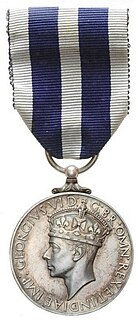
The Queen's Police Medal (QPM) is awarded to police in the United Kingdom for gallantry or distinguished service. It was also formerly awarded within the wider British Empire, including Commonwealth countries, most of which now have their own honours systems. The medal was established on 7 July 1909 as the King's Police Medal (KPM), initially inspired by the need to recognise the gallantry of the police officers involved in the Tottenham Outrage. Renamed the King's Police and Fire Services Medal (KPFSM) in 1940, it was replaced on 19 May 1954 by the Queen's Police Medal (QPM), when a separate Queen's Fire Service Medal was also instituted.
The Queen Elizabeth II Silver Jubilee Medal is a commemorative medal created in 1977 to mark the twenty-fifth anniversary of Elizabeth II's accession in the United Kingdom, Canada, Australia, and New Zealand. The medal is physically identical in all realms where it was awarded, save for Canada, where it contained unique elements. As an internationally distributed award, the Queen Elizabeth II Silver Jubilee Medal holds a different place in each country's order of precedence for honours.
The Queen's Fire Service Medal, introduced in 1954, is awarded to members of the fire services in the United Kingdom for distinguished service or gallantry. It was also formerly awarded by Commonwealth countries, most of which now have their own honours systems.

The King Edward VII Coronation Medal was a commemorative medal issued in 1902 to celebrate the coronation of King Edward VII and Queen Alexandra.

The King George V Coronation Medal was a commemorative medal instituted in 1911 to celebrate the coronation of King George V, that took place on 22 June 1911.
The King George V Silver Jubilee Medal is a commemorative medal, instituted to celebrate the 25th anniversary of the accession of King George V.
The King George VI Coronation Medal was a commemorative medal, instituted to celebrate the coronation of King George VI and Queen Elizabeth.
The Overseas Territories Police Medal (OTPM), known as the Colonial Police Medal (CPM) until April 2012, is a medal awarded for gallantry or distinguished service to all ranks of police forces and organised fire brigades in British Overseas Territories, and formerly in Crown Colonies and British Dependent Territories. Police officers in these areas can also be awarded the higher ranking Queen's Police Medal. The CPM was first awarded in 1938.
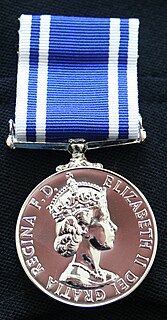
The Police Long Service and Good Conduct Medal is a decoration for police officers of the United Kingdom. First instituted in 1951, the medal is presented for twenty aggregate years of service in the police services of the United Kingdom.

The Diamond Jubilee Medal was instituted in 1897 by Royal Warrant as a British decoration. The medal was awarded to members of the Royal Family and the court, guests and dignitaries present at the celebrations of Queen Victoria's diamond jubilee and to selected soldiers and sailors who formed the jubilee parade in London.

The Golden Jubilee Medal was instituted in 1887 by Royal Warrant as a British decoration to be awarded to participants of Queen Victoria's golden jubilee celebrations.
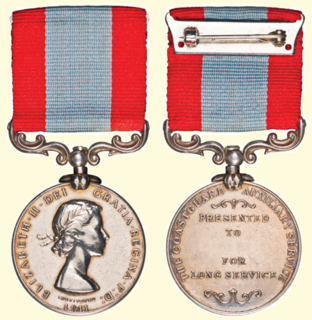
H.M. Coastguard Long Service and Good Conduct Medal is a long service medal awarded by the United Kingdom. Awarded for twenty years full or part-time service, with members of Her Majesty's Coastguard, Coastguard Rescue Service, Isle of Man Coastguard and auxiliary coastguards eligible.

The Special Constabulary Long Service Medal is long service medal awarded in the United Kingdom to members of the Special Constabulary who have completed a specified period of service. Established in 1919 by King George V, the medal was initially created to reward members of the Special Constabulary for their service during World War I.
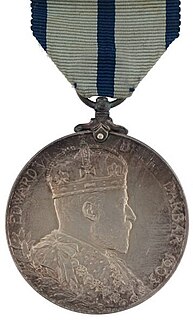
Delhi Durbar Medals were instituted by the United Kingdom to commemorate the Delhi Durbar where the new Emperor of India was proclaimed, in 1903 for Edward VII, and in 1911 for George V. On both occasions the medals were one and a half inches in diameter and were awarded in both gold and silver. They were worn in date order alongside Coronation and Jubilee medals on the left chest, suspended from a ribbon one and a quarter inches wide. These Royal commemorative medals were worn before campaign medals until November 1918, after which the order of wear was changed, with them now worn after campaign medals and before long service awards.

The Police Coronation Medal was sanctioned in 1902 as an award to policeman, firemen and members of ambulance units on duty during the official celebrations of the Coronation of King Edward VII and Queen Alexandra on 9 August 1902.

A Police Jubilee Medal was awarded to those on duty at Queen Victoria's Golden and Diamond Jubilee celebrations.
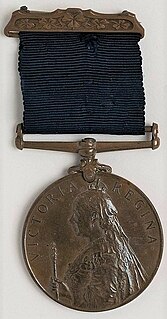
Queen Victoria's Commemoration Medal 1900 (Ireland), more commonly referred to as the Visit to Ireland Medal 1900, was awarded to those members of the Irish Police Forces on duty at Queen Victoria’s various engagements during her visit to Ireland in 1900.
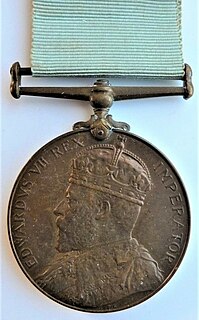
King Edward VII’s Visit Commemoration Medal 1903 (Ireland), more commonly referred to as the Visit to Ireland Medal 1903, was awarded to those members of the Irish Police Forces on duty during the various engagements of King Edward VII’s visit to Ireland in 1903. A total of 7,756 medals were awarded.
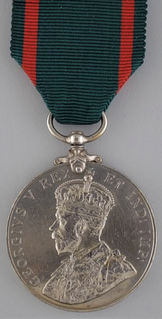
King George V's Visit Police Commemoration Medal 1911 (Ireland), more commonly referred to as the Visit to Ireland Medal 1911, was awarded to those members of the Irish Police Forces on duty during the various engagements of King George V's visit to Ireland in 1911.

Delhi Durbar Medals were instituted by the United Kingdom to commemorate the Delhi Durbar where the new Emperor of India was proclaimed, in 1903 for Edward VII, and in 1911 for George V. On both occasions the medals were one and a half inches in diameter and were awarded in both gold and silver. They were worn in date order alongside Coronation and Jubilee medals on the left chest, suspended from a ribbon one and a quarter inches wide. These Royal commemorative medals were worn before campaign medals until November 1918, after which the order of wear was changed, with them now worn after campaign medals and before long service awards.















